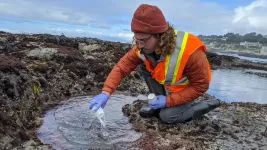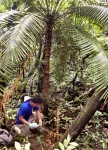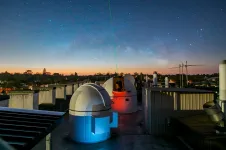INFORMATION:
The research team for the new paper included scientists from the University of Oslo, Queen's University Belfast, and George Mason University, as well as UCL and the Italian Space Agency.
The work was funded by the UKRI's Science and Technology Facilities Council, the EU's Horizon 2020 programme, NASA's Hinode programme, Invest NI and Randox Laboratories Ltd, and the Research Council of Norway through its Centres of Excellence scheme.
Magnetic waves explain mystery of Sun's outer layer
A theory as to why the Sun's outer atmosphere differs in its chemical make-up from its inner layers has been confirmed by direct observation for the first time by scientists at UCL and the Italian Space Agency.
2021-01-22
(Press-News.org) The Sun's extremely hot outer layer, the corona, has a very different chemical composition from the cooler inner layers, but the reason for this has puzzled scientists for decades.
One explanation is that, in the middle layer (the chromosphere), magnetic waves exert a force that separates the Sun's plasma into different components, so that only the ion particles are transported into the corona, while leaving neutral particles behind (thus leading to a build-up of elements such as iron, silicon and magnesium in the outer atmosphere).
Now, in a new study published in The Astrophysical Journal, researchers combined observations from a telescope in New Mexico, the United States, with satellites located near Earth to identify a link between magnetic waves in the chromosphere and areas of abundant ionised particles in the hot outer atmosphere.
Lead author Dr Deborah Baker (UCL Space & Climate Physics) said: "The different chemical compositions of the Sun's inner and outer layers were first noted more than 50 years ago. This discovery generated what is one of the long-standing open questions in astrophysics.
"The difference in composition is surprising, given that the layers are physically linked, and that matter in the corona originates in the innermost layer, the photosphere.
"Now, thanks to a unique combination of ground-based and space-based observations of the solar atmosphere, carried out nearly simultaneously, it has been possible to definitively detect magnetic waves in the chromosphere and link these to an abundance of elements in the corona that are not found in the inner regions of the Sun.
"Identifying the processes that shape the corona is crucial as we attempt to better understand the solar wind, a stream of charged particles flowing outward from the Sun, which can disrupt and damage satellites and infrastructure on Earth.
"Our new findings will help us to analyse the solar wind and trace it back to where it is coming from in the Sun's atmosphere."
The findings build on those of a related paper by many of the same authors, published last month in the Philosophical Transactions of the Royal Society, which unambiguously detected magnetic waves in the chromosphere, ruling out other factors that could have generated similar magnetic oscillations.
The existence of magnetic waves - vibrations of ions travelling in a certain direction - were first theorised in 1942 and are thought to be generated by the millions of nanoflares, or mini explosions, taking place in the corona each second.
The research team behind the new paper traced the direction of the waves by modelling a range of magnetic fields and found that waves reflecting in the chromosphere seemed to be magnetically linked to areas of abundant ionised particles in the corona.
Dr Marco Stangalini (Italian Space Agency and the National Institute of Astrophysics, Rome), a co-author of both papers, said: "The difference in chemical composition between the inner layer, the photosphere, and the corona is a feature not just of our own Sun, but of stars throughout the Universe. Thus, by observing our local laboratory, the Sun, we can improve understanding of the Universe far beyond it."
The two papers used observations acquired by IBIS, the high resolution spectropolarimetric imager at the Dunn Solar Telescope in New Mexico, together with imaging from the EUV imaging spectrometer (EIS) on the Japan/UK/USA Hinode solar observatory (an instrument designed and built by a UCL-led team) and data from the NASA Solar Dynamics Observatory (SDO).
The researchers say their findings provide a foundation for future research using data from the Solar Orbiter, a European Space Agency-mission acquiring close-up images of the Sun. The mission, which launched last February, includes instruments proposed, designed and built at UCL.
ELSE PRESS RELEASES FROM THIS DATE:
Patients of Asian and black backgrounds more likely to die from COVID, large study reveals
2021-01-22
Patients of Asian and black backgrounds suffered disproportionate rates of premature death from COVID-19, according to a study of 1,737 patients by Queen Mary University of London and Barts Health NHS Trust.
The study, published in BMJ Open, is one of the most comprehensive studies exploring COVID-19 outcomes in black, Asian and minority ethnic populations so far reported, from one of the largest and most diverse UK hospital COVID-19 cohorts, representing a majority ethnically diverse population (only 35.2 per cent of patients identified as White ethnicity).
The work resulted from a new interdisciplinary collaboration between intensive care physicians and HIV physicians. The researchers looked at data from all patients ...
Geoscientists reconstruct 6.5 million years of sea level stands
2021-01-22
TAMPA, Fla. (January 22, 2021)- The pressing concern posed by rising sea levels has created a critical need for scientists to precisely predict how quickly the oceans will rise in coming centuries. To gain insight into future ice sheet stability and sea-level rise, new research from an international team led by University of South Florida geoscientists is drawing on evidence from past interglacial periods when Earth's climate was warmer than today.
Using deposits in the caves of the Mediterranean island of Mallorca, known as phreatic overgrowths ...
Stanford: forecasting coastal water quality
2021-01-22
Less than two days of water quality sampling at local beaches may be all that's needed to reduce illnesses among millions of beachgoers every year due to contaminated water, according to new Stanford research. The study, published in Environmental Science & Technology, presents a modeling framework that dependably predicts water quality at beaches after only a day or two of frequent water sampling. The approach, tested in California, could be used to keep tabs on otherwise unmonitored coastal areas, which is key to protecting the well-being of beachgoers and thriving ocean economies ...
Methods in studying cycad leaf nutrition found to be inconsistent and incomplete
2021-01-22
Collective research to date regarding nutrients found in the leaves of contemporary cycad species has been inconsistent as far as data collection and narrow in scope, according to a University of Guam-led literature review published on Nov. 19 in Horticulturae journal.
Understanding nutrient accumulation within cycads is essential to effective horticultural management, and more importantly, conservation of this plant group, which is highly prized within the horticulture trade and also threatened worldwide.
"Cycads comprise the most threatened group of plants worldwide, ...
PTSD link to pandemic panic
2021-01-22
Even at the start of the COVID-19 pandemic last year, people around the world became more fearful of what could happen to them or their family.
A new Flinders University study of 1040 online participants from five western countries published in PLOS ONE explores people's response to the stresses of the escalating pandemic, finding more than 13% of the sample had post-traumatic stress disorder (PTSD) related symptoms consistent with levels necessary to qualify for a clinical diagnosis.
With ongoing economic and social fallout, and death toll of more than 2 million, the team of psychology researchers warn more needs to be done to cope with ...
Placental function can illuminate future disease in adults and children
2021-01-22
AURORA, Colo. (Jan. 22, 2021) - Researchers at the University of Colorado Anschutz Medical Campus have discovered a direct association between placental function in pregnant women and future metabolic disorders in children and adults, a finding that could lead to earlier intervention and diagnosis of disease.
"We've known for some time that many major diseases in adults like diabetes and cardiovascular disease are at least partly caused by problems during fetal life," said the study's senior author Thomas Jansson, MD, PhD, professor of Obstetrics & Gynecology ...
MRI helps unravel the mysteries of sleep
2021-01-22
Our state of consciousness changes significantly during stages of deep sleep, just as it does in a coma or under general anesthesia. Scientists have long believed - but couldn't be certain - that brain activity declines when we sleep. Most research on sleep is conducted using electroencephalography (EEG), a method that entails measuring brain activity through electrodes placed along a patient's scalp. However, Anjali Tarun, a doctoral assistant at EPFL's Medical Image Processing Laboratory within the School of Engineering, decided to investigate brain activity during sleep using magnetic resonance ...
Rhesus macaques develop promising immune response to SARS-CoV-2
2021-01-22
In a promising result for the success of vaccines against COVID-19, rhesus macaque monkeys infected with the human coronavirus SARS-CoV-2 developed protective immune responses that might be reproduced with a vaccine. The work was carried out at the California National Primate Research Center at the University of California, Davis and is published Jan. 22 in the journal Nature Communications.
"These results suggest that vaccines inducing durable protective immunity against SARS-CoV-2 do so by stimulating robust germinal center responses - a question that can be effectively answered ...
Record-breaking laser link could help us test whether Einstein was right
2021-01-22
Scientists from the International Centre for Radio Astronomy Research (ICRAR) and The University of Western Australia (UWA) have set a world record for the most stable transmission of a laser signal through the atmosphere.
In a study published today in the journal Nature Communications, Australian researchers teamed up with researchers from the French National Centre for Space Studies (CNES) and the French metrology lab Systèmes de Référence Temps-Espace (SYRTE) at Paris Observatory.
The team set the world record for the most stable laser transmission by combining the Aussies' 'phase stabilisation' technology with advanced self-guiding optical ...
Growing up in a bilingual home has lasting benefits
2021-01-22
New research has found that growing up in a bilingual home can provide unexpected cognitive benefits later in life.
The study, published in the journal Scientific Reports, demonstrates for the first time that adults who acquired their second language as a young child (early bilinguals) are quicker at shifting attention and quicker at detecting visual changes compared to adults who learnt their second language later in life (late bilinguals).
Led by Dr Dean D'Souza of Anglia Ruskin University (ARU), the research saw 127 adults take part in two separate ...
LAST 30 PRESS RELEASES:
Making lighter work of calculating fluid and heat flow
Normalizing blood sugar can halve heart attack risk
Lowering blood sugar cuts heart attack risk in people with prediabetes
Study links genetic variants to risk of blinding eye disease in premature infants
Non-opioid ‘pain sponge’ therapy halts cartilage degeneration and relieves chronic pain
AI can pick up cultural values by mimicking how kids learn
China’s ecological redlines offer fast track to 30 x 30 global conservation goal
Invisible indoor threats: emerging household contaminants and their growing risks to human health
Adding antibody treatment to chemo boosts outcomes for children with rare cancer
Germline pathogenic variants among women without a history of breast cancer
Tanning beds triple melanoma risk, potentially causing broad DNA damage
Unique bond identified as key to viral infection speed
Indoor tanning makes youthful skin much older on a genetic level
Mouse model sheds new light on the causes and potential solutions to human GI problems linked to muscular dystrophy
The Journal of Nuclear Medicine ahead-of-print tip sheet: December 12, 2025
Smarter tools for peering into the microscopic world
Applications open for funding to conduct research in the Kinsey Institute archives
Global measure underestimates the severity of food insecurity
Child survivors of critical illness are missing out on timely follow up care
Risk-based vs annual breast cancer screening / the WISDOM randomized clinical trial
University of Toronto launches Electric Vehicle Innovation Ontario to accelerate advanced EV technologies and build Canada’s innovation advantage
Early relapse predicts poor outcomes in aggressive blood cancer
American College of Lifestyle Medicine applauds two CMS models aligned with lifestyle medicine practice and reimbursement
Clinical trial finds cannabis use not a barrier to quitting nicotine vaping
Supplemental nutrition assistance program policies and food insecurity
Switching immune cells to “night mode” could limit damage after a heart attack, study suggests
URI-based Global RIghts Project report spotlights continued troubling trends in worldwide inhumane treatment
Neutrophils are less aggressive at night, explaining why nighttime heart attacks cause less damage than daytime events
Menopausal hormone therapy may not pose breast cancer risk for women with BRCA mutations
Mobile health tool may improve quality of life for adolescent and young adult breast cancer survivors
[Press-News.org] Magnetic waves explain mystery of Sun's outer layerA theory as to why the Sun's outer atmosphere differs in its chemical make-up from its inner layers has been confirmed by direct observation for the first time by scientists at UCL and the Italian Space Agency.



